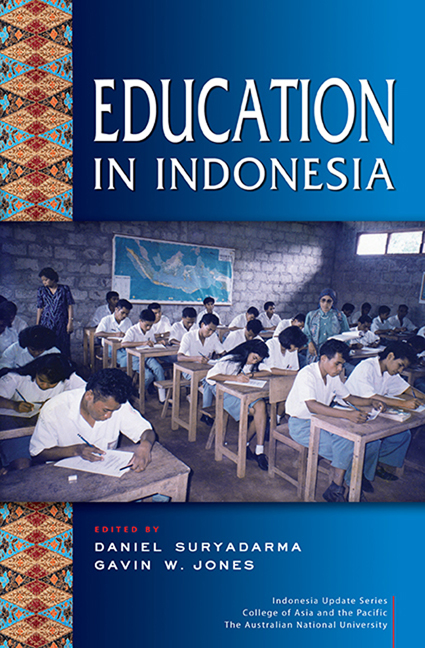Book contents
- Frontmatter
- Contents
- Tables
- Figures
- Contributors
- Acknowledgments
- Glossary
- 1 Meeting the Education Challenge
- 2 Trends in Education in Indonesia
- 3 Teacher Training, School Norms and Teacher Effectiveness in Indonesia
- 4 Integrating Islamic Schools into the Indonesian National Education System: A Case of Architecture over Implementation?
- 5 Early Childhood Education and Development Services in Indonesia
- 6 Where Did All the Money Go? Financing Basic Education in Indonesia
- 7 An Assessment of Policies to Improve Teacher Quality and Reduce Teacher Absenteeism
- 8 Indonesian Universities: Rapid Growth, Major Challenges
- 9 Beating the Odds: Locally Relevant Alternatives to World-class Universities
- 10 Financing Higher Education: The Viability of a Commercial Student Loan Scheme in Indonesia
- 11 The Transformation and Internationalization of Higher Education: The Malaysian Experience
- 12 Role of the Education and Training Sector in Addressing Skill Mismatch in Indonesia
- Index
- Indonesia Update Series
3 - Teacher Training, School Norms and Teacher Effectiveness in Indonesia
Published online by Cambridge University Press: 21 October 2015
- Frontmatter
- Contents
- Tables
- Figures
- Contributors
- Acknowledgments
- Glossary
- 1 Meeting the Education Challenge
- 2 Trends in Education in Indonesia
- 3 Teacher Training, School Norms and Teacher Effectiveness in Indonesia
- 4 Integrating Islamic Schools into the Indonesian National Education System: A Case of Architecture over Implementation?
- 5 Early Childhood Education and Development Services in Indonesia
- 6 Where Did All the Money Go? Financing Basic Education in Indonesia
- 7 An Assessment of Policies to Improve Teacher Quality and Reduce Teacher Absenteeism
- 8 Indonesian Universities: Rapid Growth, Major Challenges
- 9 Beating the Odds: Locally Relevant Alternatives to World-class Universities
- 10 Financing Higher Education: The Viability of a Commercial Student Loan Scheme in Indonesia
- 11 The Transformation and Internationalization of Higher Education: The Malaysian Experience
- 12 Role of the Education and Training Sector in Addressing Skill Mismatch in Indonesia
- Index
- Indonesia Update Series
Summary
INTRODUCTION
During one of the first research projects I conducted in Indonesia, I distributed a survey to approximately 100 junior secondary teachers. One of the questions asked instructors how often they used student-centred teaching methods in their classes. Fifty-seven per cent of respondents answered either ‘often’ or ‘always’. Yet when I observed the same people interacting with students in the classroom, I was surprised by what I saw. Teachers tended to lecture from a stationary position at the front of the room or to transcribe large sections from textbooks onto the blackboard. Rarely did I witness the interplay between student and teacher that the teachers’ survey responses suggested was a regular part of their instructional repertoires. In an attempt to establish an empirical foundation for my analysis, I recorded the specific pedagogical methods they used. The data indicated that 53 per cent of all lessons involved lecturing, while only 20 per cent involved some sort of hands-on activity and just 5 per cent included a class discussion. The contrast between teachers’ reports on their methods and the actual strategies they used with students raised a number of questions. Were the lessons I observed aberrations? Was a typical day in an Indonesian school filled with engaging activities that were put on hold on the days I happened to visit? How did teachers define ‘student-centred’ methods? Was I missing something?
The follow-up interviews I conducted with educators clarified my thinking and provided valuable insights into the motivations of the individual teachers I had observed. In describing their actions, the teachers told me that they believed they were encouraging their students to take an active role in their studies; but their definitions of what constituted active learning were telling. The three examples of active learning they most often supplied were using workbooks in class; requiring students to complete more review exercises; and assigning homework more regularly. So while I was struck by the static, teacher-centred aspects of the lessons I observed, the people facilitating those activities were firm in their conviction that they were bringing the curriculum to life for their students – and were supporting the Ministry of Education and Culture's efforts to encourage more active engagement of students in the classroom. From their perspective, they were faithfully carrying out the role that had been assigned to them.
- Type
- Chapter
- Information
- Education in Indonesia , pp. 53 - 67Publisher: ISEAS–Yusof Ishak InstitutePrint publication year: 2013

